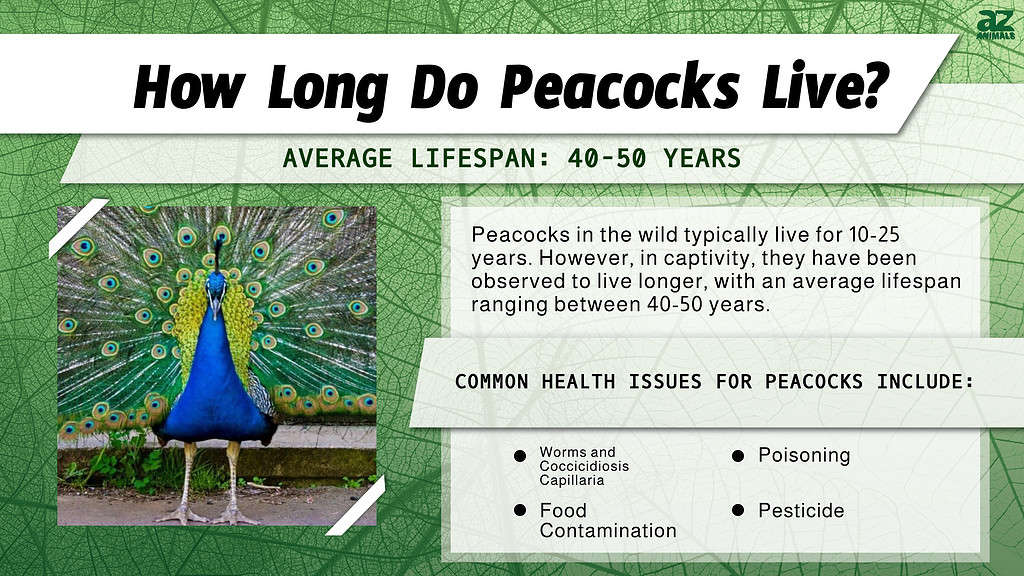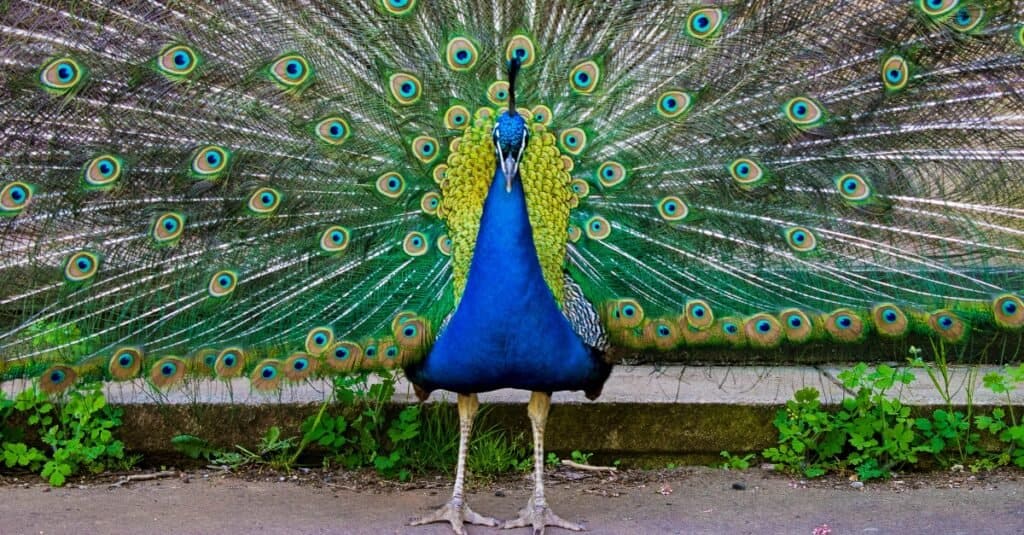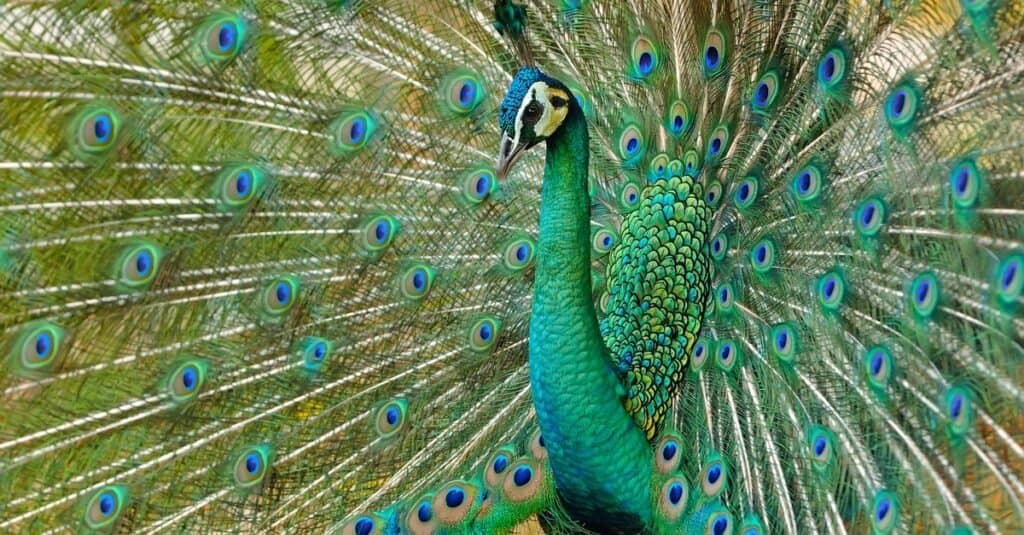
Is there any animal more truly recognizable than the peacock? Hearing the name alone leaves you with a visual of its stunning plumage with its beautiful patterning. But, outside of its beautiful exterior, how much do we really know about this mysterious bird?
You may be surprised to find out that there’s so much more than looks that make the peacock so memorable. After all, did you know that a group of peacocks isn’t called a flock but a party?
Ready to expand on your knowledge of this amazing animal? We’ve got the rundown on what makes this bird so special, including details on the peacock’s lifespan and how peacocks go from birth to adulthood.
The Rundown On Peacocks

In 1963, the blue or Indian peacock was designated India’s national bird.
©iStock.com/Anna_Brothankova
Peacocks and peahens are members of the pheasant family and are known as peafowls. Although people refer to all peacocks as “peacocks,” the term applies only to the males of the species. Peafowls are classified into two species: Indian or blue peafowl and green peafowl.
Most people are familiar with the Indian peafowl, which can be found in many zoos and parks. The Indian peafowl is native to India and Sri Lanka in South Asia. The green peafowl, also known as the Indonesian peafowl, is a peafowl species native to the tropical forests of Southeast Asia.
You may also be surprised to find out that it is the males of the species that flaunt the gorgeous plumage, while the peahens are actually a dull, brown color. Peacocks have this gorgeous plumage to attract females during their mating rituals. Peahens use this visual show to assess the fitness of the males around them. The quality of these feathers would subsequently be used as a criterion for peahens when selecting potential partners.
With all of this knowledge about the peacock, let’s look at the peacock lifespan and how long these magnificent peafowls live.
How Long Do Peacocks Live?

Peacocks can live between 10 to 25 years in the wild and up to 50 years in captivity.
©iStock.com/panda3800
In the wild, peacocks have an average lifespan of 10-25 years. In captivity, peacocks have been known to live longer, averaging between 40-50 years in age. Even though there are many differences between the peahen and the peacock, they both actually are quite similar in their lifespans.
In comparison to other poultry, peacocks have a pretty long lifespan.
Take a look at some examples to compare:
- Chickens: In the wild, chickens can live anywhere between 3 and 7 years. However, in captivity, they have been known to live much longer. They can generally live between 10-12 years of age.
- Turkeys: Turkeys living out in the wild have an average lifespan of 3-5 years. While living in captivity, they are able to outlive their wild counterparts. Captive turkeys can live up to 10 years.
- Ducks: Mallard ducks can live 5-10 years out in the wild, while captive ones can live for as long as 20 years.
Compared to some of the most well-known fowls, peacocks are generally lucky in their life expectancy. Let’s go on to learn about the peacock life cycle.
The Average Peacock Life Cycle
The peacock life cycle is quite interesting because of the fabulous mating display between the males and females. The stages of their life cycle can be broken down into mating, eggs, hatchlings, chicks, and adulthood.
Mating
The peacock’s most prevalent mating ritual is the presentation of its train. Males spread their tails in a fan form and strut back and forth, making a rattling noise with their feathers. This catches the peahen’s attention, and she is then free to choose her preferred male. Females may choose mates based on the size and quality of the plumage display. If available, male peacocks will form a harem of many females.
Eggs
After mating, the peahen will lay a clutch of three to six eggs. She will incubate them independently for around 29 days, with no assistance from the male.
Hatchlings
The young hatchling is born without feathers but can feed and swallow right away. Birds do not give their young milk, and all chicks must be ready to feed right away. Peachicks scrape and peck for little pieces of feed on the ground as hatchlings, just like adults, and may also consume small invertebrates and grasses.
Peachicks
For the first several weeks, peachicks rely on their mothers for warmth until they acquire feathering. When they no longer require the warmth of their mother, they become a part of the general flock into which they were born, with no further attention from a specific family within the wider group.
Peacocks and Peahens
Within a year, peacocks are nearly completely matured. Two-year-olds resemble adult males, but their tails lack the distinctive eyes that their older counterparts have. They become sexually active around the age of three. Peahens develop faster than peacocks and can mate as early as one year old. Others postpone their decision until the second year.
Factors That Impact The Peacock Lifespan

Peacocks routinely fly short distances to escape to a tree branch for safety from predators or to nest at night.
©Labrador Photo Video/Shutterstock.com
Peacocks don’t have many defensive capabilities. They have sharp beaks and claws, but they will lose to a larger animal almost every time. Since they are practically defenseless, they are susceptible to various threats that impact their lifespan.
Some factors that threaten the peacock lifespan include:
- Habitat Loss: While the Indian peacock is of least concern on the endangered species list, the same cannot be said for the green peafowl. It has been designated as endangered on the IUCN Red List since 2009 because the worldwide population is quickly falling and extremely fragmented as a result of habitat loss. These birds love to live in the jungle. They require regions where they may hide from huge predators and trees in which to roost. Humans are destroying more and more wooded places as they expand and spread.
- Predation: Peacocks have a lot of natural enemies out in the wild. Mongooses, raccoons, wild cats and dogs, and jungle cats such as leopards and tigers have all been reported to prey on peacocks in the wild.
- Hunting: The peacock feather trade has led to a rise in illegal hunting for peacocks in countries like India. Peacock hunting was outlawed in India to prevent the population of peacocks from dwindling again.
The photo featured at the top of this post is © iStock.com/AlexeyVis
Thank you for reading! Have some feedback for us? Contact the AZ Animals editorial team.






